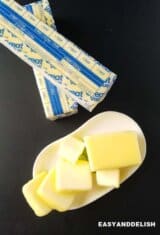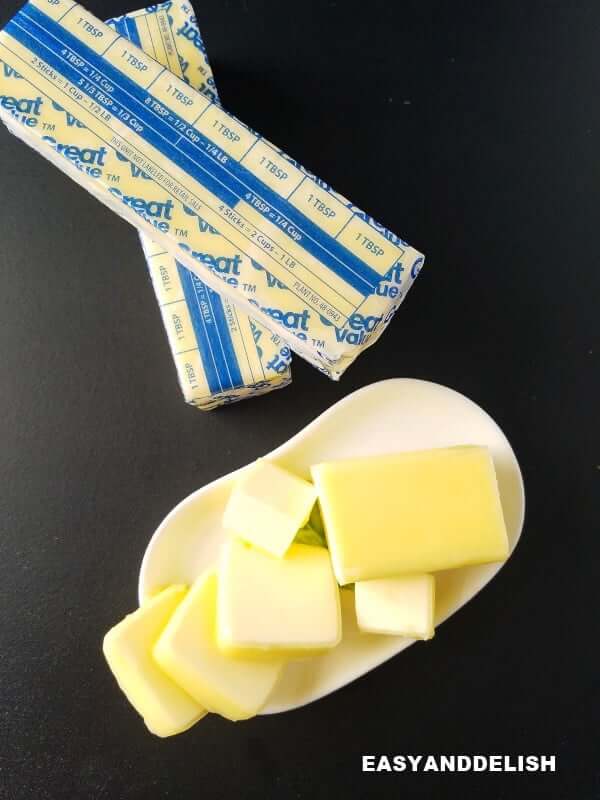How Many Grams In Quarter Cup Of Butter

Making a recipe and wondering how many sticks of butter in a cup? Our conversion charts have the precise reply! They convert from sticks to cups to grams, ounces, pounds, kilograms, milliliters, tablespoons, and teaspoons. Some apply to solid butter (weight) while others are useful for melted butter (book).
Bound to Butter Measuring Conversion Nautical chart
In the U.S., butter often comes wrapped in quarter-pound sticks with tablespoon measures (and their cup conversions) written out for united states of america on the wrapper.
In contrast, many other places sell butter in ane-pound blocks. Further, if you are ownership higher-quality imported butter, they frequently come in half-pound blocks.
That is generally the equivalent of two "sticks" of regular butter. If yous don't keep this difference in mind and go by a typical "stick" measurement, you may wind up with a very unpleasant result in your baking!

If yous can, remember that 2 sticks of butter equal one cup or 16 tablespoons. But if you lot tin't, no need to panic!
You tin can print these Conversion Charts that convert from sticks to cups to grams, ounces, pounds, kilograms, milliliters, tablespoons, and teaspoons. Some utilise to solid butter (weight) while others are useful for melted butter (volume).
Merely bear in mind that when in uncertainty, measure butter past weight for best accuracy.
Other Cooking Conversions that Yous Tin can Use:
- Baking substitutions
- Book conversions
- Temperature conversion
- How many teaspoons in a tablespoon
- U.S. cups to ounces to grams
How many sticks of butter in a loving cup (or a stick of butter in cups)
When learning how to read a recipe, there are some mutual questions well-nigh butter that tend to be asked often.
Q: "How many sticks of butter are in one loving cup?"
A: There are two sticks of butter in i cup. Each stick of butter is ½ loving cup and usually you will see cut lines on the butter wrapper for tablespoons, ¼ cup, and ⅓ cup.
Q: "Why do so many recipes phone call for unsalted butter?"
A: Yous may meet unsalted butter in the ingredient list of a recipe then besides see actual salt as an ingredient and wonder, "why use unsalted butter and then add salt?" This is a good question and the reply can be different based on the type of recipe.
In a sweet recipe, particularly a dessert that includes leavening agents that help it ascension or puff up, information technology is a must to use unsalted butter when it is called for in a recipe.
This is because the table salt in the recipe is there not and so much for season, but more for its chemical properties that tin, for one thing, adjutant in leavening.
The right balance of salt is important, so using unsalted butter helps ensure you've added the exact correct amount of table salt.
For a savory recipe, common salt does usually play an important role in the flavour of the dish.
Using unsalted butter gives you lot control over the amount of salt you add to the food every bit well as when you add together it.
Q: "How much salt is in a stick of salted butter?"
A: Depending on the brand, one stick of salt contains somewhere between a little over ¼ teaspoon salt up to just over ⅓ teaspoon salt.
If y'all take unsalted butter but need salted butter for a recipe, but add together ¼ teaspoon of additional common salt.
Q: "Tin can I use melted butter instead of softened butter when baking?"
A: In a word? No. Melting butter changes the way it will interact with the flour, saccharide, and other ingredients in the recipe and absolutely will impact the final results of the food.
Q: "Tin I use oil instead of butter in cakes, cookies, and pies?"
A: The answer to this question is tricky because it very much depends on the recipe. If you need to use oil instead of butter, bank check kickoff to see if the recipe calls for creaming together butter and sugar.
This process is key for some recipes every bit it adds air to the butter and sugar mixture, creating a lite and fluffy texture.
Beating oil and sugar together simply will not yield the aforementioned result and so it would be all-time to use butter or a solid vegetable shortening.
In theory, yes, you can usually use oil instead of butter in the same amount chosen for in the recipe. However, be aware that the flavor and texture of the broiled goods volition likely be altered.
Q: "Can I freeze butter?"
A: Yes, absolutely! If you meet a great sale on butter, yous may desire to stock upwardly and freeze it to utilise later. Butter can be kept fresh in your habitation freezer for up to three months.
Do you have more than questions about ingredient substitutions, measurement conversions, or whatever topic not covered above related to following a recipe? Leave me a comment beneath!
Sticks of Butter to US Cups and Grams
| BUTTER Book | Us CUPS | GRAMS |
|---|---|---|
| half (½) stick of Butter | ¼ cup | 56.7 1000 |
| 1 stick of Butter | ½ loving cup | 113.4 k |
| two sticks of Butter | 1 cup | 226.8 g |
| 4 sticks of Butter | two cups | 453.half-dozen grand |
Sticks of Butter to Ounces and Pounds
| BUTTER Book | OUNCES | POUNDS |
|---|---|---|
| half (½) stick of Butter | 2 oz | ⅛ lb |
| 1 stick of Butter | 4 oz | ¼ lb |
| 2 sticks of Butter | 8 oz | ½ lb |
| four sticks of Butter | 16 oz | ane lb |
Butter Sticks to Kilograms and Milliliters
| BUTTER Volume | KILOGRAMS | MILLILITERS |
|---|---|---|
| half (½) stick of Butter | 0.056 kg | 62.5 mL |
| one stick of Butter | 0.113 kg | 125 mL |
| two sticks of Butter | 0.226 kg | 250 mL |
| 4 sticks of Butter | 0.452 kg | 500 mL |
Butter Sticks to Tablespoons, Grams, and Teaspoons
| BUTTER VOLUME | TABLESPOONS | TEASPOONS | GRAMS |
|---|---|---|---|
| half (½) stick of Butter | 4 tbsp | 12 tsp | 56.7 1000 |
| one stick of Butter | eight tbsp | 24 tsp | 113.iv one thousand |
| ii sticks of Butter | sixteen tbsp | 48 tsp | 226.8 g |
| 4 sticks of Butter | 32 tbsp | 96 tsp | 453.vi |
How Many Grams In Quarter Cup Of Butter,
Source: https://www.easyanddelish.com/cooking-conversions/how-many-sticks-of-butter-in-a-cup/
Posted by: dustinhatiltas.blogspot.com


0 Response to "How Many Grams In Quarter Cup Of Butter"
Post a Comment